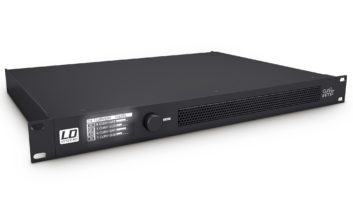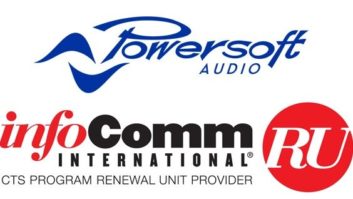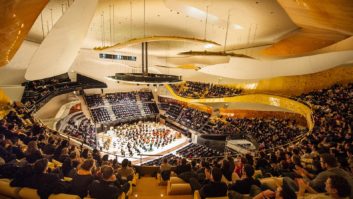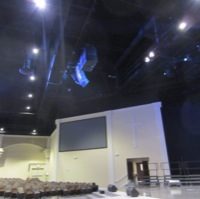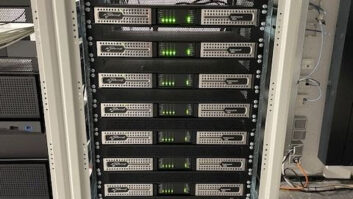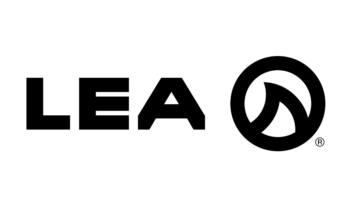Manufacturers are using a combination of software features and operating mode options to meet the needs of installation applications of all sizes.
d&b’s install first includes advanced user control
d&b audiotechnik’s 10D and 30D amplifiers – the company’s first amplifiers designed for permanent installations – incorporate DSP for loudspeaker management, switchable filter functions, remote control capabilities and advanced user-definable control.
The advanced DSP capabilities deliver two 16-band equalisers with parametric, notch, shelving and asymmetric filters, as well as up to 10 seconds of delay for each channel. Both models can use d&b ArrayProcessing, which integrates within the ArrayCalc simulation software. It applies filter algorithms to optimise the tonal (spectral) and level (spatial) performance of the line array column over the audience area.
The 10D and 30D differ only in their output voltage and loudspeaker configurations; both are designed for integration within installed sound reinforcement solutions. Integration within the d&b remote network means that these amplifiers can be combined with other d&b amplifiers through either CAN-Bus or via Ethernet using the OCA protocol.
Yamaha offers impedance flexibility
Yamaha’s multi-channel XMV series comprises of eight models with varying output power capabilities and flexible in/out connectivity. The amplifiers are also part of Yamaha’s Commercial Installation Solutions (CIS) range and are suited to use in hotels, cinemas and theatres.
XMV amplifiers can operate in both high and low impedance modes simultaneously, which eliminates the need for additional equipment as well as enabling both 70V and 100V operation for every pair of channels.
The models come equipped with either the YDIF digital audio format, which allows set-up with the use of Ethernet cables, or Dante networking, used for larger venues where long distance cabling is required. In addition, the newly developed Double Power Mode doubles the output power of selected channels to drive speakers with higher output power. Therefore, speakers with varying output capabilities can be powered simultaneously by the same amplifier.
Another feature of the XMV range is a new switching power supply equipped with Power Factor Correction, which ensures harmonic control and decreases the amount of current draw while maintaining the same output power.
Crown expands networked solutions with high power units
Crown’s DCi 4|2400N and DCi 2|2400N power amplifiers are the latest additions to the DCi Network Series, incorporating Harman’s DriveCore chip for high power output. The two models are compact, with a 2RU form factor and also offer extensive networked system control capabilities.
Both amplifiers offer direct drive ‘constant voltage’ without the need for a step up transformer, which produces higher audio quality in distributed audio applications.
The Network Series includes networked monitoring and control via primary and secondary Ethernet ports. They are also compatible with Harman’s HiQnet Audio Architect system software and utilise TCP/IP-based protocol in HiQnet for network monitoring and control. All series amps have BLU.ink compatibility with a low-latency, fault-tolerant digital audio bus, capable of routing 256 channels via Cat5e cable up to 300ft (91m) between devices.
Lab.gruppen adapts with loudness contouring
The two Lucia 70V amplifiers from Lab.gruppen combine the ability to drive distributed loudspeaker systems with a compact form factor. The Lucia 120/1-70 and 240/1-70 amplifiers also include built-in DSP, input selection/mixing and configurable GPIO facilities.
Lucia amplifiers include ADLC (Automatic Dynamic Loudness Contouring), which automatically adapts to the content and level to ensure a better listening experience. This means they are well suited for background music, small constant-voltage distributed systems and applications where the level may vary.
The compact form factor of Lucia models, a half-rack 1RU chassis, makes them useful when there is no convenient equipment rack, and a range of mounting options are available. Lucia amplifiers also incorporate advanced features for protection of both the amplifier and connected loads to improve reliability, and have Energy Star approval, reducing running costs.
The 120/1-70 and 240/1-70 models bring the number of amplifiers in the Lucia range up to six, with programmable DSP and various I/O configurations.
Powersoft adds sound shaping and monitoring options
The Ottocanali Series DSP+D from Powersoft supplements the main Ottocanali series, offering a wide range of system control and monitoring functions as well as sound shaping options. The output power reaches 12,000W at 4 ohms over eight channels for low-Z or distributed line systems, in a 2RU.
The DSP+D Series has two redundant universal switch mode power supplies for reliability, with power factor correction and patented Smart Rails Management technology reducing power consumption. Flexible routing/mixing provided by the internal 8 x 8 input/output matrix allows the user to mix and route analogue and digital I/O. The series is also compatible with Powersoft’s Armonia Pro Audio Suite, which enables users to manipulate advanced DSP features of the system via a single GUI and includes Dante networking.
The three high-performance power amps that make up the Ottocanali DSP+D Series are designed specifically for install applications, with a full DSP engine from the flagship X Series for touring.
Electro-Voice meets install needs with tailored solution
The Electro-Voice CPS 4.10, part of the Contractor Precision Series of amplifiers is available in compact 2RU configurations of up to eight channels.
Each model in the CPS range features Phoenix-type I/O connectors, programmable power-on delay, and switchable high-pass filters. The applications that the 4.10 targets include cinema, club sound, commercial sound/life safety, and a variety of performance venues.
CPS amplifiers have Class D design for efficiency, and the optional RCM-810 module enables the inclusion of CPS amps in IRIS-Net networks (up to 250 devices) as well as Variable Load Drive for independent channel impedance. Using IRIS-Net software, users can monitor and control complex sound systems remotely via computer, tablet or touchpanel through an individual GUI.
QSC provides remote control capability for corporate environments
The SPA2-60 and SPA4-60 from QSC’s SPA amplifier series offer two and four channels of low-Z output bridged to provide 70V or 100V output. The additional channels on the SPA4 enable solutions such as a pair of stereo channels with a single 70V or 100V output, or a Sub/Sat combination.
This series of amplifiers targets the corporate AV market and applications such as boardrooms and conference rooms where multiple speakers are in use. The remote control capabilities are useful in corporate environments, such as standby mode for fire and safety paging, and for corporate applications, the aesthetics of the amps blend in.
The SPA Series is housed in a half-sized 0.5in RU chassis with rack, table and wall mounting options included. It is Energy Star compliant to meet LEED certification in corporate buildings.
Kling & Freitag optimises performance with speaker presets
Kling & Freitag’s K&F D series consists of the K&F D 200:4, 120:4 and 80:4, and is a range designed specifically for installation applications.
The D Series is the only range of amplifiers from Kling & Freitag with all the K&F speaker presets. The presets make it simpler for the customer to set up the amplifiers, and with CAFÉ Software it is also easy to configure and monitor all of the amps in a network.
The D series, which is based on models of the same name from Lab.gruppen, includes RPM (rational power management), which means the overall output of the power amps can be flexibly distributed over the different amp channels. Additional features include power factor correction, universal power adapters and various inputs such as Dante, AES and analogue.
The high-performance power amps are based on the newly developed Lake core modules and K&F module presets for optimal performance of loudspeaker systems; in the future they will be able to operate all standard K&F systems.
